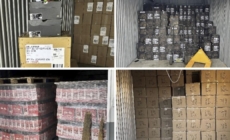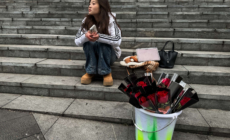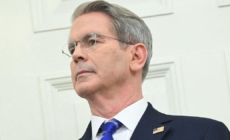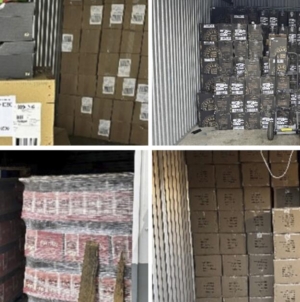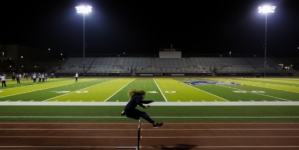-
Bitcoin-mining computers among loot stolen by international theft crew - 11 mins ago
-
Texas Man Arrested for Beating Mother to Death During ‘Exorcism’: Police - 23 mins ago
-
Jimmer Fredette, AP college player of the year in 2011 and 2024 US Olympian, retires from basketball - 26 mins ago
-
High hopes but long odds against a GOP governor in California - 52 mins ago
-
Swarm of helpful robots can pack your groceries - about 1 hour ago
-
China’s Economy Faces Rise of ‘Rat People’ - about 1 hour ago
-
Tough love from Eric Chavez set up Francisco Lindor’s hot start to 2025 - about 1 hour ago
-
Treasury chief Scott Bessent says U.S. has an “an opportunity for a big deal” with China - about 1 hour ago
-
Duchess of York opens up about cancer diagnoses, advocates for young patients - about 1 hour ago
-
Trump’s DOJ targeted L.A. County over gun permits. Who might be next? - 2 hours ago
Despite progress, Los Angeles is still nation’s smoggiest city
Despite decades of progress in reducing air pollution, Los Angeles is still the nation’s smoggiest city, according to a report released Wednesday by the American Lung Assn.
The association’s annual “State of the Air” report noted that Los Angeles held on to the infamous title for the 25th time even though the number of unhealthy ozone days has dropped nearly 40% since 2000. Particle pollution metrics told a similar story, where Los Angeles saw improvement but still had the dubious honor of being the nation’s seventh-most polluted city by that measure.
California is home to five of the country’s 10 smoggiest places, as defined by levels of ozone pollution, and also to five of the worst 10 cities by particle pollution, according to the report. Los Angeles, Visalia, Bakersfield, Fresno and San Diego were among the list of cities most polluted by ozone. Bakersfield, Visalia, Fresno, Los Angeles and Sacramento were in the top 10 for worst particle pollution.
The report comes roughly a month after the Environmental Protection Agency, under the Trump administration, announced its plan to loosen or eliminate a wide swath of environmental regulations that many experts worry could negatively effect air quality, reversing decades of progress in California.
“Nobody wants to go back to the kinds of skies that triggered our clean air laws in the first place,” Mary D. Nichols, a UCLA law professor and former chair of the California Air Resources Board, said during a news conference Tuesday.
At the EPA, the Trump administration seeks to “roll back existing rules that have been effective in protecting public health” she said, as well as eliminating staff positions and removing science and research functions.
If the EPA is dismantled, “we’ll have more sick kids. We’ll have more people going to the hospital with asthma attacks,” Nichols said. “We’ll see people dying sooner than they should have just because of the poison in the air.”
The “State of the Air” report tracks two main types of air pollution: ozone pollution, largely a factor of tailpipe emissions and heat, and particle pollution, driven primarily by drought and wildfires. The report found that more than 34.3 million Californians live in a community with at least one failing air quality grade and 22.9 million live in a community with three failing air quality grades.
Southern California has been choked by smog since the mass adoption of the automobile. Millions of cars and trucks in the region release a vast amount of vehicle exhaust, which forms smog when it’s cooked in the perennially sunny climate. The mountain ranges restrict airflow and prevent pollution from dispersing.
State and local regulators have adopted a number of nation-leading rules to reduce emissions from vehicles and industrial facilities, including Senate Bill 32 in 2014 and Assembly Bill 398 in 2017, which enacted strict greenhouse gas emission limits and a cap-and-trade system.
While electric vehicles and cleaner car engines have significantly reduced pollution, transportation remains the largest source in California’s major cities. Heavy-duty trucks, cargo ships and trains are some of the biggest contributors to regional pollution.
Despite the lackluster results, a dozen California cities including Los Angeles posted their best-ever reports on either ozone or particle pollution, said Mariela Ruacho, a senior clean air advocacy manager at the American Lung Assn.
Fresno improved across the board, registering its lowest ever number of ozone days and particle days and its lowest annual particle levels since tracking began in 2000.
Meanwhile, Bakersfield earned the title of the city in America with the least healthy air. The San Joaquin Valley town ranked as the most particle-polluted city in the nation, both for short-term and annual levels, according to the report.
“Phasing out agricultural burning, maintaining state investments in cleaning up heavy-duty trucks, and off-road agricultural equipment incentives are critical to ongoing local progress,” the American Lung Assn. wrote in a news release.
Though California’s air quality has improved significantly since the first “State of the Air” report in 2000, concerns over climate change and new legislation abound. California Senate Bill 712, which would fully exempt collector cars at least 35 model years old from smog check requirements, would “set our progress back decades,” Ruacho said.
“Unhealthy air is inequitable and unaffordable,” Ruacho said. “To protect against these costly health emergencies, California must double down on investments to reduce wildfire risk, spur zero-emission transportation and energy sources, and align transportation funding with pollution reduction needs.”
Times staff writer Tony Briscoe contributed to this report.
Source link
